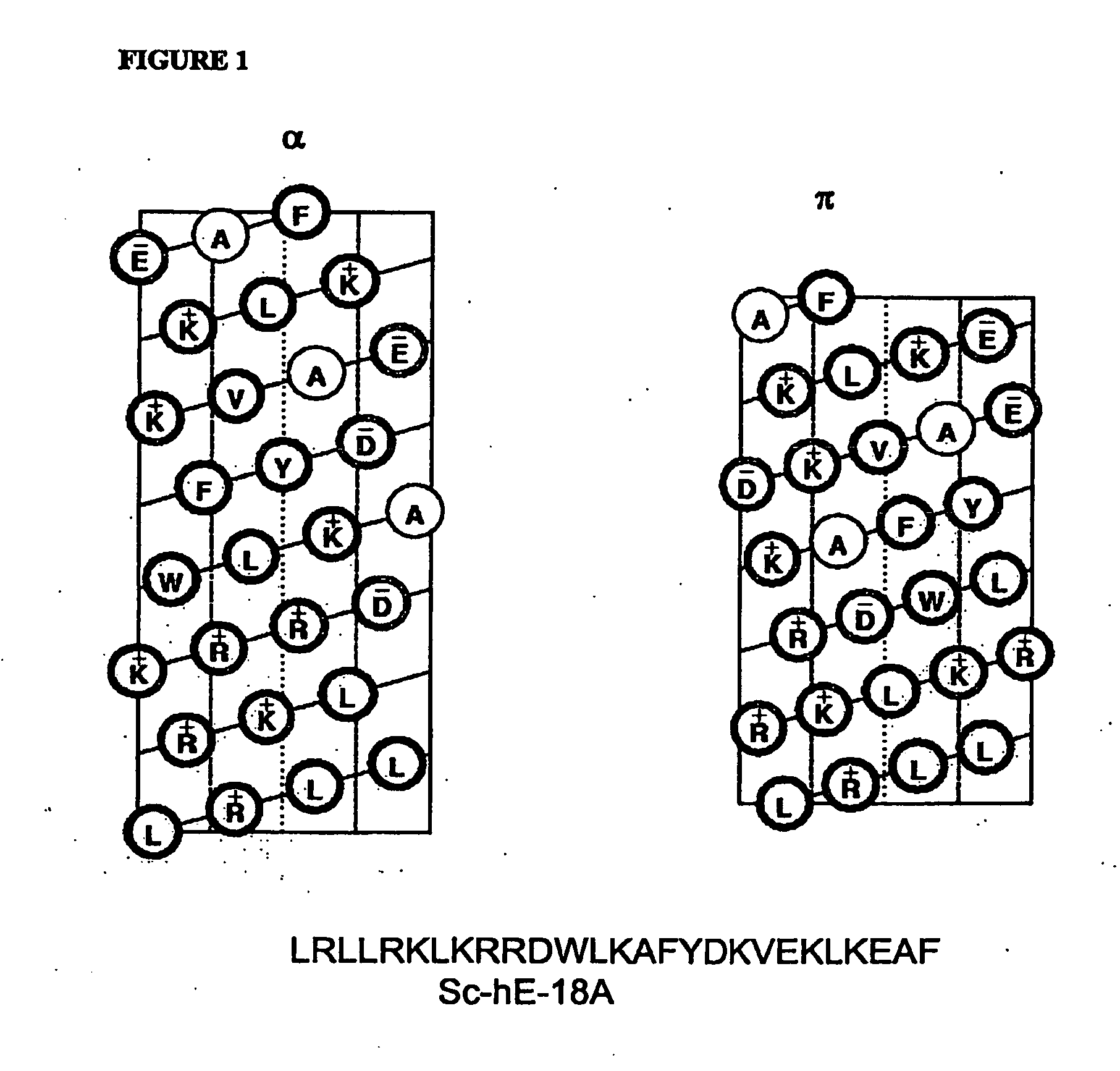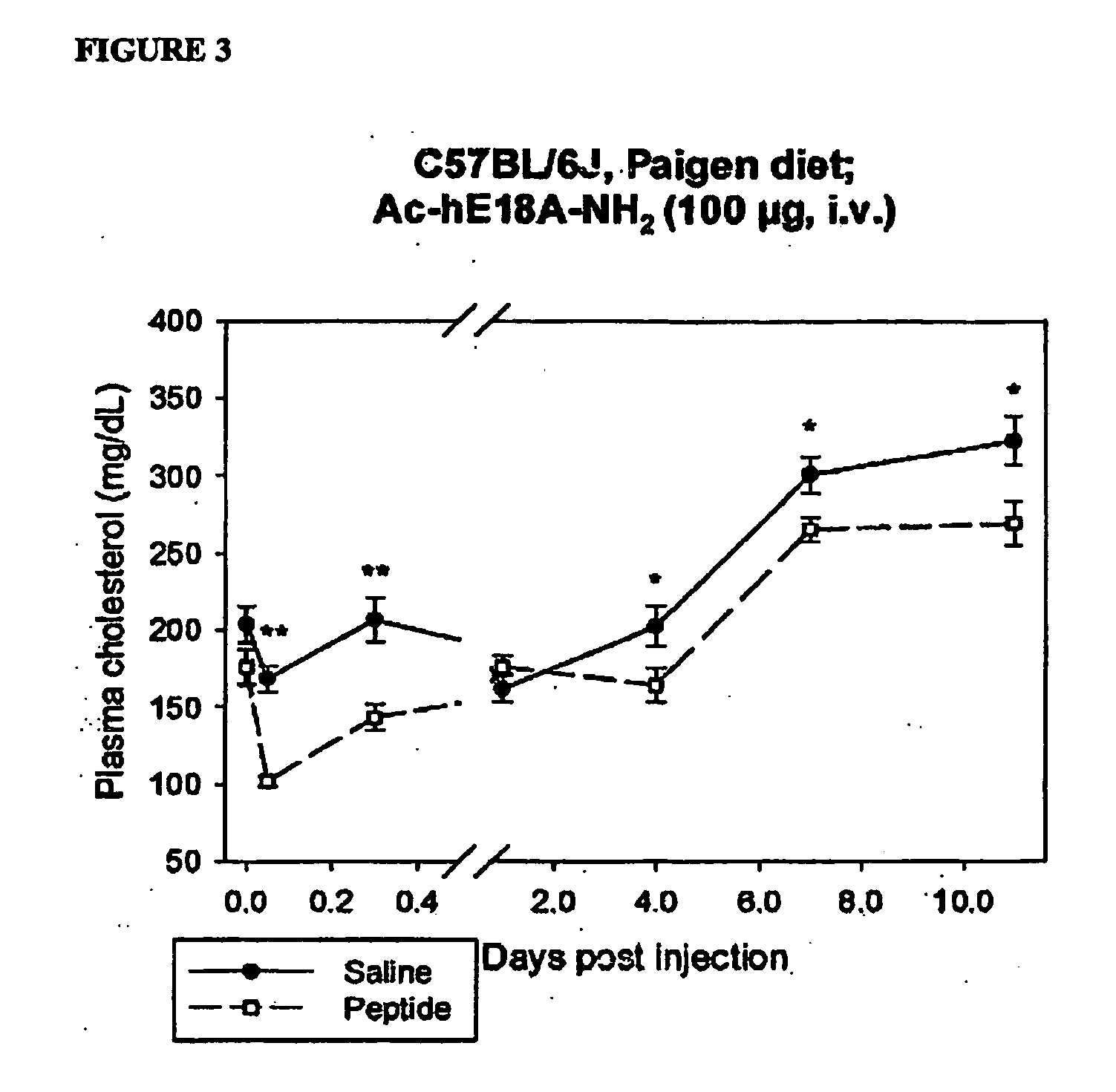Synthetic apolipoprotein e mimicking polypeptides and methods of use
a polypeptide and synthetic technology, applied in the field of protein biology, can solve the problems of increased plasma cholesterol, increased oxidative stress, increased triglyceride-rich lipoproteins, etc., and achieve the effect of improving endothelial function and increasing pon activity
- Summary
- Abstract
- Description
- Claims
- Application Information
AI Technical Summary
Problems solved by technology
Method used
Image
Examples
example 1
Effect of Cationic Dual-Domain Peptides on Atherogenic Lipoprotein Uptake
[0275]The effect of the peptide Ac-LRKLRKRLLR-18A-NH2 (Ac-hE18A-NH2; SEQ ID NO: 12) in HepG2 cells and in dyslipidemic mouse models has been previously described (5, 6, 7, 8, 9). These studies demonstrated that the peptide Ac-hE-18A-NH2 (and not LRKLRKRLLR or Ac-18A-NH2) associates with atherogenic apo B-containing lipoproteins in human plasma. It was also shown that the peptide is able to enhance the uptake and degradation of LDL and VLDL in HepG2 cells Datta, G. et al. Biochemistry 39:213-220 2000). Preliminary results have shown that LDL-receptor was not involved in the clearance of plasma cholesterol. In dyslipidemic mouse models, studies showed that the peptide is able to associate with apo B48-containing lipoproteins and enhance their uptake and degradation (Datta, G. et al. Biochemistry 39:213-220 2000). In C57BL6 mice fed an atherogenic diet, apo E null mice, apo E(null)-LDL-R(null) double knockout mic...
example 2
Ac-hE-18A-NH2 Inhibits Atherosclerosis in Apo E Null Mice
[0276]Atherosclerosis inhibition studies in apo E null mice that develop atherosclerosis spontaneously were also performed. Retroorbital administration of Ac-hE-18A-NH2 (50 μg / mouse, 3 times weekly) for four weeks into sixteen week old female apo E null mice showed decreased lesion by 40% (p value <0.001) compared to the control group (n=11 in control and n=12 in peptide administered group). In this administration procedure, there was no loss of animals and no visible injury to animals was observed, despite multiple administration (of a total of 12 administrations). Lesion analysis was performed using the en face preparations. Sixteen week old mice would have well established lesions. These results (FIG. 2) show that the peptide is able to inhibit lesion formation in apo E null mice. These results are in agreement with the peptide being antiatherogenic. Detailed studies on the mechanism of the inhibition of atherosclerosis ar...
example 3
[0277]It has been shown that a portion of apo E on triglyceride-rich lipoproteins, as well as on HDL is internalized and recycled (Swift, L. L. et al., J. Biol. Chem. 276:22965-22970 2001; Farkas, M. H. et al., J. Lipid Res. 45: 1546-1554 2004). Liver cells can internalize apo E which is eventually re-released. Administration (i.v) of 100 μg of the peptide Ac-hE-18A-NH2 in to C57BL / 6J mice (n=9 in each group) fed an atherogenic diet showed a biphasic effect on plasma cholesterol levels. Initially peptide decreased plasma cholesterol by >65%. Lower total cholesterol levels were observed even after 8 days in the peptide administered group compared to the control group despite continued atherogenic diet administration (FIG. 3). Effect on plasma cholesterol is seen even after the disappearance of the peptide from plasma. It is possible that the apo E-mimetic peptide is recycled. To understand the mechanism by which the peptide is able to exert such a dramatic effect, the effects of the ...
PUM
| Property | Measurement | Unit |
|---|---|---|
| time | aaaaa | aaaaa |
| temperature | aaaaa | aaaaa |
| pH | aaaaa | aaaaa |
Abstract
Description
Claims
Application Information
 Login to View More
Login to View More - R&D
- Intellectual Property
- Life Sciences
- Materials
- Tech Scout
- Unparalleled Data Quality
- Higher Quality Content
- 60% Fewer Hallucinations
Browse by: Latest US Patents, China's latest patents, Technical Efficacy Thesaurus, Application Domain, Technology Topic, Popular Technical Reports.
© 2025 PatSnap. All rights reserved.Legal|Privacy policy|Modern Slavery Act Transparency Statement|Sitemap|About US| Contact US: help@patsnap.com



